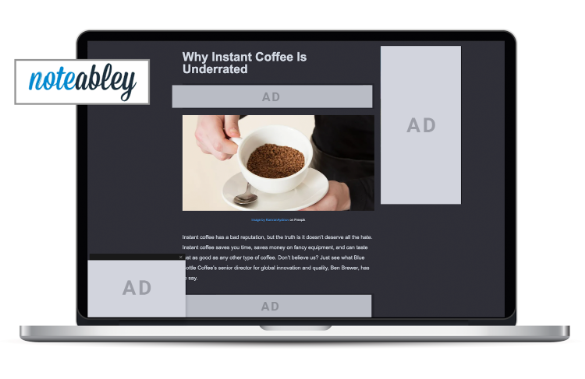Today at DoubleVerify, we are releasing a preview of findings from our eighth annual Global Insights Report. This report analyzes media quality and performance trends across more than one trillion impressions from over 2,000 brands in 100 markets. Our findings highlight the global impact of “Made for Advertising” (MFA) websites.
MFA websites prioritize advertising revenue over delivering value to visitors, often resulting in a poor user experience and higher short-term profits for site operators.
MFA sites typically exhibit most or all of the following characteristics:
- High Ad-to-Content Ratio: MFA sites typically feature a disproportionately high number of ads relative to actual content. Ads on these platforms may frequently refresh during a single user visit, which in turn maximizes potential revenue from each viewer.
- Dependence on Paid Traffic: Rather than relying on organic growth through content quality and SEO, MFA sites often depend heavily on paid traffic sources such as social media. This strategy focuses on drawing immediate traffic, regardless of the quality or relevance of the content.
- Engagement Tactics: Content on MFA sites is designed to keep users scrolling endlessly or clicking through multiple pages within the same site. This approach aims to increase the likelihood of ad impressions and clicks.
- Content Duplication: MFA sites commonly reuse content verbatim across various domains. This tactic allows for the rapid creation of multiple sites with minimal effort, often sacrificing originality and quality.
- Low Ad Intensity: On MFA sites, the ad intensity is often low, indicating that ads are not viewed for as long or as frequently as those on more reputable sites. This metric helps identify sites where user engagement with ads is minimal, further indicating a focus on quantity over quality of ad interactions.
MFA sites impact every stakeholder in the digital ecosystem, including brands, publishers, and consumers.
- Impact on Brands: MFA sites can dilute the effectiveness of a brand’s advertising. Ads placed on lower-quality sites may not reach the intended audience or achieve the desired outcome. This wastes budgets and can harm the brand’s reputation by associating it with subpar content and poor user experiences.
- Impact on Publishers: MFA sites negatively impact legitimate publishers, as these platforms divert both audience and advertising dollars away from high-quality content. The proliferation of MFA sites increases competition for ad placements, often leading to lower ad rates for publishers. Additionally, the presence of these low-quality sites can erode trust in online advertising overall.
- Impact on Consumers: For consumers, MFA sites contribute to the degradation of their online experience, a phenomenon sometimes referred to as the “enshittification” of the Internet. These sites prioritize ad revenue over user satisfaction, leading to frustrating navigation, overwhelming ad loads, and repetitive, low-quality content. This environment not only diminishes the quality of information available to consumers but also can lead to ad fatigue, which hurts the overall ad ecosystem.
Growth in MFAs
In June 2023, the Association of National Advertisers (ANA) reported that MFA sites comprised 21% of all programmatically purchased ad impressions (programmatic is the automated buying and selling of online ads) and attracted 15% of total advertising spend amid concerns that new Gen AI tools were accelerating the production of inappropriate content.
DV’s analysis shows a 19% year-over-year increase in MFA impression volume in 2023. The growth was primarily driven by a 73% increase in “Low-tier” MFA impressions, which appear on hybrid sites that include a mix of MFA and non-MFA characteristics.
The AI Connection
A study by Copyleaks recently revealed a sharp increase in the growth of AI content on the web, surging 8,362% from November 2022, when ChatGPT 3.5 was released, to March 2024. Additionally, a number of recent studies have linked the growth of generative AI content online to a rise in spam, misinformation, fraud, and low-quality content, more broadly.
With that in mind, DV commissioned Sapio Research to survey 1,000 global advertisers about the connection between AI and online content quality. The survey revealed that 57% of respondents consider AI-generated content a significant challenge for the digital ecosystem, 54% believe generative AI has degraded media quality, and 50% identify the proliferation of MFA and low-quality content as the greatest threat to the digital ad landscape.
To further explore the connection between MFA sites and AI-generated content, DV has built its proprietary technology to detect and analyze replicated and AI-generated content across digital platforms. Using this advanced technology, DV analyzed a sampling of over three dozen “High-tier” MFA websites, those demonstrating the most severe MFA characteristics. DV found multiple instances of content that was likely AI-written, including the following examples:
- HeroInvesting: Stars Showing Significant Aging Over Ten Years – Clint Eastwood
- Noteabley: Best Steakhouses in America
- CarterFive: Outfits for the Music Award
During one user session, the HeroInvesting article displayed over 70 ads, with several ads auto-refreshing roughly every 15 seconds. (The article in question has seemingly been deleted by HeroInvesting.)

Similarly, the Notabley article featured more than 110 ads from beginning to end, including multiple video ads that auto-played and refreshed continually. The CarterFive article also had over 40 ads, presenting similar behaviors.

MFAs & User Attention
MFAs may appear high-performing when looking at specific isolated KPIs, such as clicks and viewability, that they are designed to boost. Despite this, DV found that MFA sites deliver 7% less overall attention on display ads and 28% less on video than other media. “High-tier” MFAs, in particular, were 25% below the attention baseline.
This below-average attention performance is driven by poor exposure (e.g., intensity, viewable time, share of screen, presentation, audibility, etc.), rather than engagement (user touches, screen orientation, video playback, audio control interactions, etc.). MFAs, however, are explicitly designed for certain engagements, further underscoring the need for comprehensive attention-based measurement that considers both exposure and engagement.
“MFA content has surged, powered by Gen AI,” said Mark Zagorski, CEO of DoubleVerify. “Additionally, the worst offenders perform very poorly in terms of attention—an increasingly important metric for brands. It’s critical for advertisers to identify, measure, and avoid problematic MFA content in real-time to drive better, authentic performance.”
The proliferation of MFA sites, fueled by the advancements in generative AI, marks a critical juncture for the advertising industry. As DoubleVerify’s report suggests, understanding and mitigating the impacts of these sites is essential to safeguarding the interests of brands, publishers, and consumers alike, thereby ensuring a trustworthy digital advertising environment.
Methodology
The report employs DV technology to analyze over one trillion impressions, both pre and post-bid, and offers a detailed market-by-market analysis for North America, LATAM, EMEA, and APAC. It covers video and display impressions from January to December 2023 across desktop, mobile web, mobile app, and connected TV (CTV). The study also includes a global survey conducted by Sapio, polling 1,000 advertisers across North America, LATAM, EMEA, and APAC. DV introduced tiered MFA categories in 2024, and applied that methodology to 2022-2023 impressions to determine year-over-year analysis. DV also analyzed over three dozen examples of “High-tier” MFA websites to identify instances of content that were likely AI-generated.

